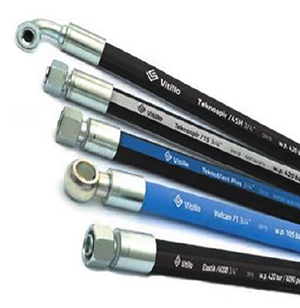Hose manufacturer Vitillo suggests these steps for proper hose crimping:
 1. Select the hose, ferrules and inserts.
1. Select the hose, ferrules and inserts.
2. Cut the hose squarely, using a rotary steel blade to the required length.
3. If skiving is required, remove all rubber cover to the “skiving length” specified in the table, avoiding damage to the steel wires reinforcement.
4. Place the ferrule fully onto the hose. Push the insert fully into the hose. Select the “COLLAPSE CONTROL MANOREL.” Insert the MANOREL into the insert bore. The “NO GO” part of the MANOREL must fully go into the insert bore. Remove the MANOREL.
5. Crimp the ferrule to the diameter specified in the table.
6. Inspect the crimp diameter by measuring it on each die impressions. All measurements must be taken
in the center of ferrule length. All measurements must be according to the specified crimping diameters, within a tolerance +0.01-0.2 mm.
7. Insert the “COLLAPSE CONTROL MANOREL.”
8. If the “NO GO” part of the MANDREL stops in the bore the crimping diameter and the bore collapse are correct.
9. If the “NO GO” part of the MANDREL goes through the bore, the crimping diameter must be reduced
by increments of 0.1 mm.
10. If the “GO” part of the MANDREL does not go through the bore, the crimping diameter must be increased.

Finn-Power machines have an automated product for that called PINNING. there is a video on our webpage under Applications. Also used in Slip Fits like tent poles, fencing, etc…
I would like to know for return line cut hoses (Low pressure), what is the ideal position for worm clip ?
1. How the torques are decided for different hoses ?
2. What are the international standards for these hoses ?
Many engineers position the clamp on the straight portion & do not pay attention to keep it on the stepped diameter. Without proper documents, I am unable to demonstrate this to juniors.